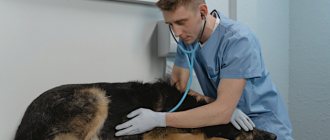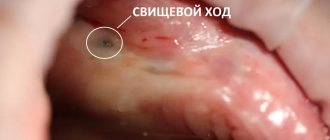Your dog has started coughing. What with her? Got a cold, choking or heart problems? The causes of cough in a dog can be very different, so you need to find out what happened to your pet and start treatment.
There is no need to delay the start of the examination, since coughing causes great discomfort to the dog and can be the first sign of complex and life-threatening diseases.
Causes of cough in dogs
Dogs cough for two reasons: physiological and pathological. The former are not dangerous, but can frighten inexperienced owners. The latter directly threaten the health of the pet and arise as a result of mechanical damage or internal disorders. If they are found, you will have to contact a veterinarian.
Physiological reasons include:
- Anatomical features of brachycephalic breeds (pugs, Shih Tzu, Pekingese). Due to the shortened muzzle, animals experience “reverse sneezing” syndrome, accompanied by a rare and quickly passing cough.
- Accumulation of fur inside the stomach. Most often found in long-haired breeds. With the help of the cough reflex, the pet regurgitates the accumulated hairs, preventing intestinal blockage. If this does not happen, purchase a special paste or dry food that dissolves hairballs directly in the stomach.
- Wrong choice of collar. If your pet coughs when the leash is pulled, then its collar is too narrow. In this case, it is recommended to purchase a harness or choose a wider analogue.
Understanding how to treat a dog’s cough is only possible after a diagnosis has been made. Triggering factors include allergies, infections, helminths, malignancies, chest injuries and foreign bodies stuck in the throat. In these pathologies, the cough reflex is a secondary symptom that can only be eliminated together with the root cause.
What to do if your puppy is choking and can't breathe
Sometimes a cough can be triggered by a foreign body entering the pet's respiratory tract. From the outside it looks like this: the dog was eating or playing with objects and suddenly suddenly began to cough. If your dog is choking, you can tell by the common symptoms:
- accompanied by vomiting;
- the dog looks scared;
- rubs his muzzle with his front paws, as if trying to remove the muzzle;
- if the breathing process is disrupted, the pet begins to weaken, and the mucous membranes acquire a bluish tint.
If your dog chokes, immediately help him and, if necessary, remove the foreign object from the respiratory tract.
Types of kennel cough and associated symptoms
Cough syndrome is classified according to several indicators. It can be wet and dry, acute and chronic, rare and frequent, minor and paroxysmal. The veterinarian will need this information when collecting anamnesis, so record it before going to the veterinary clinic - monitor your pet as carefully as possible.
The broadest classification includes the relationship with physiological and pathological causes. Let's look at the main types in more detail.
Aviary
The aviary (kennel) species is named after the most common cause of infection - crowded housing in enclosures. When one animal becomes infected, all its companions become ill. Depending on the causative agent of the disease (parainfluenza viruses, Bordetella bacteria), the symptoms shown include:
- inflammation of the lymph nodes;
- discharge from the nasal sinuses;
- elevated temperature;
- profuse tearing.
A mixture of viral and bacterial infections is called tracheobronchitis. The first signs appear within 10 days from the date of infection. The dog develops a paroxysmal cough, as if it is choking, but treatment is not always required. If the animal is vaccinated and has a strong immune system, then after 2 weeks the symptoms disappear on their own. In other cases, a complication in the form of pneumonia is possible, so do not forget to check the sick person with a veterinarian.
Allergic
The allergic species caused by flowering is characterized by seasonality. Dry coughs are accompanied by:
- discharge from the eyes and redness of the whites;
- sneezing and itching;
- swelling of the mucous membranes;
- the appearance of skin rashes and redness.
Try to find out why your dog is coughing, using the most common allergens as a basis: pollen, food, household chemicals, tobacco. If attacks occur upon direct contact with one of the allergens, try to eliminate it.
Cordial
The heart type of cough in dogs is easily recognized by the pinkish sputum. This color is due to blood entering the pulmonary alveoli. Their permeability increases with increased blood pressure caused by stagnation in the pulmonary circulation. Cough syndrome is accompanied by painful attacks. A sick dog has a hard time coughing. Symptoms are complemented by:
- lethargy and weakness (the pet refuses walks and exercise);
- blue gums;
- the appearance of shortness of breath.
Such signs are typical for mitral regurgitation, and in representatives of large breeds - for dilated cardiomyopathy. Most often, heart problems are diagnosed in older dogs.
“
Dry coughing, accompanied by whistling and attacks of suffocation, is also characteristic of tracheal collapse. This pathology, which causes softening of the cartilage rings and thinning of the trachea, is usually found in small breed pets.
Infectious and viral
Damage to the respiratory tract by viruses, fungi or bacteria is called infectious. The most dangerous type is pneumonia, that is, inflammation of the lung tissue. Regardless of the pathogen, symptoms of the disease include:
- decreased activity;
- increased temperature and the appearance of fever;
- increased heart rate;
- decreased appetite and sudden weight loss;
- gurgling cough accompanied by sputum production.
When a dog coughs dryly, as if it is choking, there is a high probability of tracheobronchitis. In the absence of fever, self-treatment is acceptable, but veterinarians recommend undergoing diagnostics.
Asthmatic
During attacks of bronchial asthma, the dog begins to choke and wheeze painfully. From the outside it seems that he choked on food or choked on a foreign object. The disease occurs due to prolonged exposure to allergens, adverse weather conditions, infectious diseases or stress. Symptoms of asthma include:
- secretion of a small amount of clear and thick sputum;
- sneezing and red eyes;
- blue mucous membranes.
Whistling sounds are accompanied by a short inhalation and a long exhalation. Most often, attacks occur after exercise.
Helminthic
The helminthic variety is rare, since worms usually live in the intestinal region. It is diagnosed when infected with trematodes Alaria alata through food. In this case, the parasites develop in the lung tissue for 2 weeks and then migrate to the intestine, where they reach maturity.
If left untreated, the cycle is constantly repeated, causing acute poisoning of the body. Among other helminths and nematodes, heartworms are dangerous. These parasites live in the heart ventricles, causing blockage of blood vessels.
The patient's temperature rises and breathing becomes difficult, and traces of blood appear in the sputum. Immediately after infection, intestinal upset and stomach pain occur.
The dog choked
When a dog is licking its lips, coughing as if it was choking, and constantly swallowing, look into its mouth. If you find a stuck thread or New Year's tinsel, carefully pick it up with tweezers and pull it out.
In other cases, contact a veterinary clinic. An independent attempt to remove sharp objects is fraught with injury to the larynx. When internal tissues are damaged, foam and blood are released.
Do not hesitate to consult a doctor if you notice any warning signs. If a foreign object remains in the throat for a long time, it can cause inflammation of the airways.
“ Read more about how to help a choking dog
Adenovirus
Treatment of dogs for cough caused by adenovirus is carried out in isolation from other pets. This respiratory disease is highly contagious and dangerous for puppies. For prevention purposes, vaccination is recommended.
After infection with the virus, the infected person develops an increasing cough syndrome and runny nose, and the larynx becomes inflamed. When palpated, a sore throat and inflammation of the lymph nodes are noted. A cloudy liquid discharge appears from the eyes and sinuses. A slight increase in temperature is acceptable. In later stages, vomiting, diarrhea, pain in the abdomen and right hypochondrium appear.
Oncology
The danger of cancer lies in the asymptomatic course in the early stages. The only possible symptom is a dry cough. The tumor can be noticed using fluorography, so do not neglect diagnosis.
At a later stage, symptoms are supplemented by rapid fatigue, shortness of breath and chest pain. The first traces of blood are noted in the expectorated sputum. As the tumor enlarges, the pain syndrome and frequency of hemoptysis increase, dizziness and loss of coordination are added. Without treatment, the animal dies due to exhaustion and complete respiratory failure.
What drugs can cure dog disease?
The dosage of the drug is prescribed by a veterinarian depending on the age and size of the animal.
Depending on the nature of the disease, the dog may be prescribed:
- Steroid drugs;
- Bronchodilators
- Bronchodilators;
- expectorants;
- vitamin A;
- vitamin C;
- vitamin E;
- Echinacea.
Cough in small breed dogs
In addition to brachycephalics, small breed dogs are also at risk. The specific structure of their respiratory tract increases vulnerability to dental diseases and various infections. The low location of the tonsils leads to a strong narrowing of the larynx when they become inflamed. This is accompanied by shortness of breath and difficulty breathing.
If the tonsils are often inflamed, it is recommended to remove them. For prevention purposes, veterinarians recommend paying special attention to oral hygiene and visiting the dentist at least 2 times a year.
Specialist help and dog treatment
An early visit to the doctor will help avoid many complications. It is in a clinical setting that all the necessary examinations can be carried out and a correct diagnosis can be made. After an external examination and palpation, the animal’s temperature will be taken and the oral cavity will be examined. They may order tests and an x-ray.
Most often, a specialist prescribes drug therapy. Antibiotics, anthelmintics and various other drugs are used according to the symptoms.
Always follow your doctor's orders. Under no circumstances give animals any traditional tinctures or vodka. They can cause severe poisoning, which can lead to death.
Diagnostics in a veterinary clinic
At the appointment, it is necessary to describe the frequency of attacks, the nature and duration of the cough syndrome. To make a diagnosis, blood tests, ultrasound, ECG, bronchoscopy and x-rays are used. The causative agent of the infection is determined by sputum analysis. After a comprehensive examination and identification of the cause, the veterinarian determines what to give the dog for cough.
You will have to take your dog to the veterinary clinic for diagnosis in any recurring case of cough. A one-time attack should generally not cause alarm - unless it is caused by a foreign object in the throat.
Why does the dog cough?
Many diseases cause coughing in dogs:
- Ingestion of foreign objects into the respiratory system.
- Infections transmitted from other dogs.
- Problems with the lungs and bronchi.
- Filling the pleural area with fluid or air.
- Throat diseases.
- Worm infestation.
- Oncological diseases.
- Problems with gums and teeth.
- Hereditary diseases.
- Problems associated with the structural features of the muzzle.
- Cardiovascular diseases.
- Allergic reactions.
Only after identifying the causes of the cough are treatment tactics for the dog determined and the duration of therapy is determined.
How to help a dog with a coughing attack
If the attack lasts and suffocation occurs, urgent assistance will be required. If you do not have the opportunity to go to a veterinary clinic, use the following recommendations:
- Pinch your pet's nose and gently run your palm over his throat. This is effective for reverse sneezing syndrome.
- Turn the dog onto his back so that his body and paws are higher than his head. Gently shake him and pat him on the back. If the animal is too big, lift its hind legs and pat its chest.
- Check the larynx and free it from foreign objects.
Provide oxygen and perform cardiac massage. For this:
- place your pet sideways on a flat surface;
- open his nostrils and breathe air into them with your mouth;
- place your hands on the animal’s ribs behind the elbows and press on them every 5 seconds;
- continue to repeat the steps for at least 10 minutes;
- after the mucous membranes turn pink and the heart function stabilizes, call a veterinarian;
- do not move the dog and monitor its condition until the doctors arrive.
The depth and duration of inhalations through the nose depends on the size of the animal. The larger the pet, the deeper and longer the breaths should be.
“ Regardless of the recommendation you choose, contact your veterinarian. After suffocation occurs, diagnosis is mandatory.
Treatment of laryngopharyngeal reflux
Lifestyle changes and diet are the main approach in the treatment of LPR and GERD. The role of drug therapy is more controversial. It is unknown whether asymptomatic patients with incidentally detected signs of LPR require treatment. There are theoretical concerns that LPR may increase the risk of malignancy, but this has not yet been proven. In any case, patients with asymptomatic LPR are advised to follow a diet.
Patients are advised to quit smoking, alcohol, and avoid foods and drinks containing caffeine, chocolate, and mint. Prohibited foods also include most fruits (especially citrus fruits), tomatoes, jams and jellies, barbecue sauces and most salad dressings, and spicy foods. Small meals are recommended.
You should avoid exercise for at least two hours after eating, and refrain from eating or drinking three hours before bedtime.
Drug therapy usually includes proton pump inhibitors (PPIs), H2 blockers, and antacids. A PPI is recommended for six months for most patients with LPR. This figure is based on the results of endoscopic studies (this is the time needed to reduce laryngeal edema), as well as the high percentage of relapse in the case of a three-month course of therapy. Discontinuation of therapy should be carried out gradually.
If therapy with PPIs and H2 blockers is unsuccessful, treatment with tricyclic antidepressants, gabapentin and pregabalin should be considered, since one of the possible mechanisms for the development of reflux is increased sensitivity of the larynx.
Treatment of cough in dogs depending on the cause
It makes no sense to treat cough in dogs until the cause is identified. Symptomatic therapy is effective only in a complex that involves eliminating the causative agent of the disease.
Eliminating allergies
Allergy attacks are eliminated by minimizing contact with the allergen. In case of hay fever (“seasonal fever”), the walking time is reduced and the usual routes are changed; in case of food allergies, hypoallergenic food is used.
Treatment comes down to taking antihistamines or ASIT therapy, which involves the introduction of a diluted allergen with a gradual increase in its concentration. For bronchial asthma, glucocorticoids or veterinary spencer are prescribed.
Therapy for colds and infectious diseases
If your dog is coughing due to an infection, your veterinarian will explain what to do to eliminate it. Regardless of the pathogen, complex therapy is used, including the following medications:
- antibiotics or antivirals;
- expectorants or mucolytics;
- anti-inflammatory;
- antipyretics;
- cardiac;
- antiemetics and other medications.
To restore immunity, the veterinarian prescribes vitamins and immunomodulators. During treatment, the pet must be provided with complete comfort, protection from drafts and gentle nutrition.
Treatment of adenovirus
Drug assistance is based on intramuscular or subcutaneous administration of immunoglobulin or interferon. Nasal and eye discharges are treated with solutions of boric acid, furatsilin or potassium permanganate.
For the intestinal form, antiemetic and antidiarrheal drugs are prescribed. It is also necessary to take sorbents.
Help with mechanical damage
Foreign objects are removed surgically. Self-extraction using oils or drugs that stimulate vomiting is unacceptable.
What to do if you have a heart cough
The animal is limited in physical activity and prescribed a set of medications that support heart function. Diuretics are prescribed to relieve swelling.
In advanced situations, surgical intervention is permissible. Due to its high cost and complexity, the operation is rarely performed. Life expectancy with this diagnosis is no more than 4 years after the onset of the disease.
Deworming
To eliminate helminths, anthelmintics are used. The most effective are complex drugs that act on several types of parasites at once. Ideally, anthelmintics should be given to your dog once a quarter.
Laryngophangeal reflux and GERD
Although stomach acid is common to both LPR and GERD, many differences exist, making LPR a distinct clinical entity.
- A prerequisite for GERD is heartburn, which is reliably observed only in 40% of patients with LPR.
- Most patients with GERD have evidence of esophagitis on biopsy, while patients with LPR have evidence of esophagitis in only 25% of cases.
- GERD is thought to be a problem of the lower esophageal sphincter and occurs primarily when lying down. In contrast, LPR is seen primarily as a problem of the upper esophageal sphincter, and occurs primarily in an upright position during exercise.
- To form LPR, much less acid exposure is required than with GERD.
There are significant differences between the mucous membrane of the esophagus and larynx.
- The upper limit of normal for acid reflux into the esophagus is considered to be up to 50 episodes per day, while 4 episodes of reflux into the larynx is no longer considered normal.
- In the larynx, unlike the esophagus, which eliminates acid through peristalsis, refluxate persists much longer, causing additional irritation.
- The epithelium of the larynx is thin and poorly adapted to combat caustic chemical damage from the same pepsin and acid.
Causes of sore throat
Inflammatory. The most common cause of a sore throat and dry cough is acute respiratory diseases. These are infections caused by various pathogens:
- viruses (parainfluenza, influenza, respiratory syncytial virus, enterovirus);
- bacteria (streptococci, staphylococci);
- fungi (for example, yeast of the genus Candida).
Infections are transmitted mainly by airborne droplets, as well as by contact. Their maximum incidence is observed in the cold and damp seasons. An infectious agent, penetrating the body, is fixed on the mucous membranes of the respiratory tract, where, in response to its penetration, a protective reaction in the form of inflammation is triggered. Swelling and redness of the mucous membrane develop, leading to discomfort, pain and sore throat, causing coughing.
Non-inflammatory. A sore throat and dry cough can also occur with non-inflammatory damage to the mucous membranes of the upper respiratory tract:
- for allergic pharyngitis, laryngotracheitis, bronchitis;
- thermal irritation of the respiratory tract (inhalation of hot or cold air);
- irritation from chemical agents (ingress of particles and vapors of varnishes, paints, household chemicals, gasoline, etc.);
- strong vocal stress (“lecturer’s” laryngitis);
- smoking;
- injury or foreign body entering the lumen of the larynx, pharynx, trachea.
In addition to respiratory diseases, tickling and dry cough may occur:
- against the background of the use of certain medications (ACE inhibitors, diuretics);
- with heart failure;
- hypothyroidism and after surgery on the thyroid gland (damage to the laryngeal nerve leads to hoarseness, sore throat without coughing);
- diabetes mellitus;
- neuroses.











